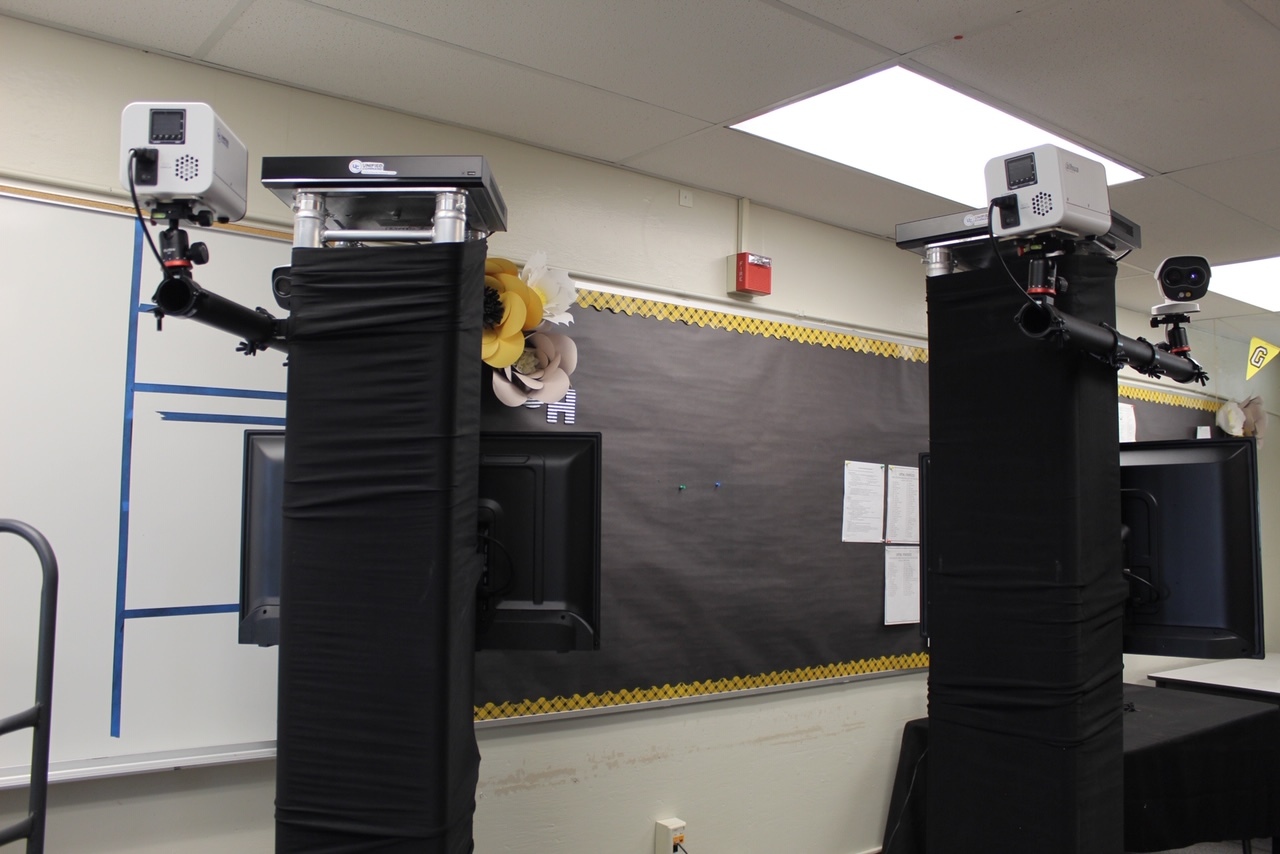This is the first of a series of stories dealing with the scheduled Nov. 2 reopening of Sunny Hills High School and what COVID-19-related safety and health measures the Fullerton Joint Union High School District [FJUHSD] has approved for teachers and students when the hybrid learning model replaces the current distance learning situation.
When teachers and students return to Sunny Hills Nov. 2 for live classroom instruction, they will have to follow a series of COVID-19-related safety and health protocols, including getting their temperatures scanned by either of the two $15,000 thermal cameras and making sure to remain six feet apart at all times.
According to a Sept. 15 email from principal Allen Whitten, a PDF file titled, “SHHS Opening and Safety Plan,” temperature screenings will be required — one called, “passive,” and the other known as “active.”
The “passive” screening must be done at home and involves students using the Qualtrics screening application that can be downloaded on a personal phone or home computer.
Through the app, students have access to a basic survey in which they will be prompted to answer questions in relation to their physical health that day.
As soon as students fill out the online guided survey, the Sunny Hills site will receive an immediate email report from Qualtrics with a live dashboard displaying the results of their survey completion.
Students who come to school without completing the Qualtrics survey will have the opportunity to fill it out on their phones. However, if they choose not to consistently prioritize the passive screening or any other safety guidelines, they will be expelled from the campus and have to resort to switching to Cohort C for full school day distance learning.
“The guidelines that are not being complied with will be addressed with zero tolerance,” Whitten said. “They are very reasonable and simple to follow, but if students don’t comply with everything we put out, then they can stay home in Cohort C.”
The “active” temperature screening involves the two, nearly seven feet-tall, towering thermal cameras placed on campus with the following procedures that all must follow:
- Anyone entering the campus before the start of each school day must enter through the main hall entrance in between the Administration Offices — Room 3 — and the 20s wing.
- If parents plan to drive and drop off their children, they must do so either outside the administration wing or the east parking lot near the Performing Arts Center [PAC]. That’s also the only lot open for students who wish to drive to and park their cars on campus.
- Anyone who comes to campus after first period must check in at the attendance office, where a smaller thermal camera costing $500 is available for active temperature screening.
“The main hallway we chose to station the thermal cameras provides them with [the best] coverage,” Whitten said. “It is also the most central area on campus, so it was a logical choice.”
Aside from the main hallway, all entryways will be roped off to ensure students pass through the thermal cameras. The assistant principals and campus supervisors will be stationed along these areas to monitor and guarantee that students do not avoid the scanning.
The plan’s “active” temperature screening will involve two newly purchased thermal cameras, each costing $15,000 and A smaller device costing $500 has been installed in the attendance office.
“The [larger] cameras have the ability to detect an accurate temperature even when masks are worn,” according to the site plan. “The cameras have the ability to scan three persons per second; up to 5,000 people in 30 minutes. This allows for accurate, safe and efficient temperature monitoring.”
As the chairman of the district’s health and safety committee, Whitten said he was instrumental in coming up with these Unified command thermal imaging cameras.
“I actually identified this vendor and recommended them to the district,” he said. “From there, we held demos from three different vendors and believe we have the most reliable and user-friendly product on the market.”
The plan consists of the additional protocols after students have passed the active temperature screening, meaning their temperature was detected at less than 100 degrees Fahrenheit:
- School officials will distribute to students who pass the screening a wristband, indicating clearance to enter campus.
- Each day, students will have a different colored wristband issued.
- Students will be educated and encouraged to avoid large group gatherings while arriving to or leaving campus.
- To keep socially distanced, students will follow the directional walkways as indicated on the ground, signage on walls and a campus map for going from one class to another throughout the school day.
- Administrators and campus supervisors will monitor that students remain socially distant before school, at break, during passing periods and after school.
The disposable, Tyvek wristbands students receive after passing the active screening area will vary in color from day to day to ensure that students do not reuse wristbands from previous days in the week to enter campus without having their temperatures taken.
School officials also encourage students to cut off their wristbands after school when they return home to further reinforce the prevention of reused wristbands.
In the case that the wristband happens to fall off, students must report to the attendance office where their temperatures will be scanned again with a hand held thermometer before receiving a new wristband.
Whitten said he understands that students will naturally want to give hugs or handshakes to their friends as they return to school, but he encourages them to remember that keeping each other safe is the No. 1 priority.
“Administrators will be outside … reminding them to distance and avoid crowding,” Whitten said. “But if students aren’t doing it on their own, and we have to give them more than one warning, they will be sent [back to distance learning only].”
For any students who don’t pass the on-campus temperature screening, the plan lists the following actions:
- The individual’s temperature will be verified through a secondary screening using the no-touch thermometer.
- If their temperature remains above 100.4 degrees, either a staff or security member will escort students to the PAC, where they will wait for their parents to take them home or for an ambulance to take them to a hospital depending on what other severe symptoms the student shows.
- If students were to be identified as having any illness-related symptoms during the school day, they will again be escorted by an administrator or security member to the PAC.
As far as the possibilities of parents sending their sick children to school, Whitten said he has tremendous faith that students and families will do the right thing to keep others around them safe.
“Nobody wants to get anybody else sick or put them in danger,” he said. “I’m very confident that our SH families will do the right thing.”
Finally, as with most places nationwide now, students must bring and wear face coverings. The plan listed the following circumstances when this is required:
- While in classrooms
- While waiting to enter campus
- While on school grounds (unless seated eating or drinking)
- While leaving school
- While on the bus (if one is provided for students)
Upon reopening, the principal said he expects students to remain in compliance with the school’s regular dress code policies of wearing over their face no images depicting alcohol or drugs or other inappropriate forms of expression.
Though it may take some time for students to adjust and accept such new policies, Whitten said students are well-prepared to safely welcome students back onto campus in a new regulatory fashion.
“It’s really important for all of us to do our best when we return [because] we’re all in this together,” he said.
Be sure to check back to The Accolade’s online news website for the next part of the series in which we focus on what the protocols for the school day will be once the first period of the day starts and what would the COVID-19 socially distanced classroom look like.








Allen Whitten • Oct 26, 2020 at 8:42 am
Great job Kate and all of the Accolade staff!! SH thanks you for keeping everyone informed!!